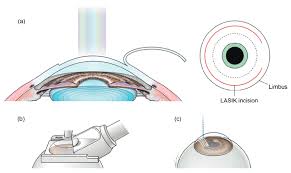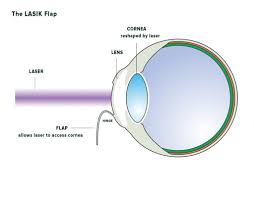Table of Contents
ToggleMyopia or nearsightedness, hyperopia farsightedness, and astigmatism are some of the visual issues that can be fixed by LASIK (Laser-Assisted in Situ Keratomileusis). During the operation, a precision laser is used to reshape the cornea, the front surface of the eye. So, What are the Lasik Prescription Requirements?
A small flap is made on the surface of the cornea during LASIK, and it is subsequently folded back to reveal the inner tissue. The cornea is subsequently reshaped to rectify the refractive defect using the excimer laser to remove a particular amount of corneal tissue. The flap is gently adjusted, and since it spontaneously adheres, no stitches are required.
By enhancing the eye’s capacity to conduct light onto the retina, LASIK seeks to increase visual clarity and sharpness. The technique is renowned for its quick healing time, which frequently enables patients to enjoy better eyesight within a day or two. After LASIK, a lot of people noticed a dramatic decrease in their need for glasses or contact lenses.
The degree and stability of the refractive defect, the thickness of the eye’s cornea, the size of the pupil, and the overall health of the eyes all play a role in determining a patient’s candidate for LASIK. A skilled eye surgeon must be consulted to determine fitness for the surgery and to go through any possible risks and advantages. Numerous people have had their lives completely changed by LASIK since it offers a quick and easy way to cure eyesight problems.
Lasik prescription requirements
When deciding whether a patient is a good candidate for LASIK, eye doctors consider a number of different variables. The patient’s prescription is one of those, and it is quite important. The following criteria are often included in the prescription requirements :
The magnitude of Refractive Error:
One important factor is the magnitude of refractive error, which is measured in diopters (D). For people with mild to severe refractive problems, LASIK is most effective. This might include prescriptions for myopia that range from -1.00 D to -10.00 D. Prescriptions for astigmatism up to around -6.00 D and for hyperopia typically range from +1.00 D to +6.00 D. Alternative therapies could be suggested if the value exceeds these limits.
Prescription Stability:
For LASIK to be successful, a steady prescription is necessary. Usually, between one and two years, surgeons demand that a candidate’s prescription be unaltered over that time. Regression (the reappearance of refractive error) is less likely when there is stability, which assures that the refractive error has stabilized.
Corneal Thickness :
For LASIK, the cornea must be thick enough. There should be sufficient tissue to deal with because the procedure’s construction of a corneal flap might cause the cornea’s thickness to decrease. Typically, surgeons strive for a corneal thickness of 500 micrometers or less.
Corneal Shape and Topography :
The cornea’s shape and topography are examined to determine whether or not it is suitable for LASIK. Due to possible difficulties, irregular corneal forms like keratoconus may disqualify a candidate for LASIK.
Pupil Size :
Particularly in low light situations, larger pupils may increase the chance of suffering glare, halos, and other visual distortions following LASIK. To reduce such post-operative consequences, surgeons measure pupil size in relation to the treatment zone.
Age and General Eye Health :
LASIK is frequently advised for those over the age of 18 since the eyes usually stabilize by this time. Candidature for LASIK may be impacted by the existence of specific eye disorders such dry eye syndrome or cataracts.
Realistic Expectations :
Candidates for LASIK must have reasonable expectations regarding the results of the operation. However, LASIK can considerably reduce or even completely remove the need for glasses or contacts. For some jobs, some applicants could still need minimal corrective eyeglasses.
Medical background and way of life :
To find any elements that could impact the safety and effectiveness of the procedure, a thorough medical history assessment is carried out. Decision-making may be impacted by lifestyle factors, including profession and interests.
Refractive error correction may not be as exact as needed due to undercorrection or overcorrection. This may leave you with residual astigmatism, nearsightedness, or farsightedness that may need to be corrected.
Regression :
The corrected vision may become blurry over time due to the normal aging process of the eyes. This can call for improvements or additional processes.
Issues with Halos, Glare, and Night Vision :
Some people have visual disturbances like Halos, and Glare, or trouble seeing at night. These side effects frequently diminish as the eyes recover.
Final Words
Numerous people now enjoy better visual clarity and a higher quality of life thanks to LASIK vision correction surgery. The prescription conditions for LASIK candidature, however, are not met by everyone.
The extent and stability of the refractive defect, corneal thickness and shape, pupil size, age, general eye health, and other characteristics are all thoroughly assessed by eye surgeons. The distinct qualities of each applicant are taken into account to guarantee the finest results and safety.
Consult a skilled ophthalmologist if you’re thinking about getting LASIK so they can determine your candidature and make specific recommendations. Recall that the success of LASIK depends on Lasik Prescription Requirements like comprehensive pre-operative examination, post-operative care, and reasonable expectations in addition to achieving the prescription criteria.













